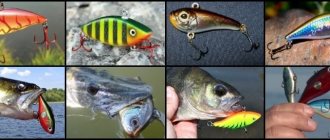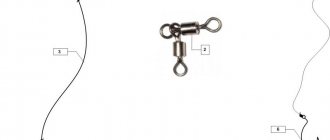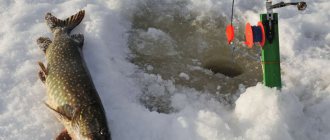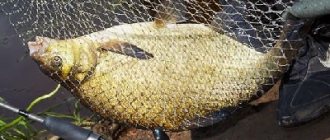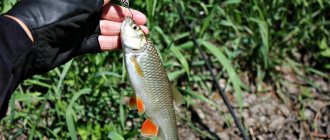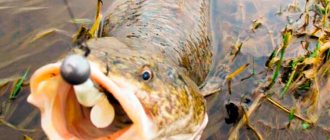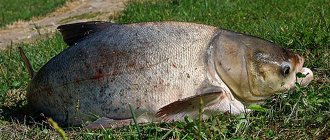author of the article Yuri Zheltyshev
Hello, dear readers of the “School of Fishing”! Finally, albeit with a significant delay, jerking (that is, fishing with special baits, jerkbaits) came to us. At the same time, quite unexpectedly, this fishing method became super popular, of course, among advanced fishermen.
What is the reason for this popularity? Well, firstly - and this applies primarily to those who already know how to catch predators in other ways - fish are actually caught using jerky, and often very trophy fish are caught. Secondly, the fishing process itself is so exciting that it captivates those advanced fishermen who are interested not only in the result, but also in the thrill of fishing.
Why jerky? The fact is that it is this method of fishing that gives the angler a chance to bite a large, trophy pike. And who wouldn’t dream of catching a predator that’s worth fighting, that you’re not ashamed to show to your friends? Without any doubt, jerking is spinning fishing for advanced spinners who are strong in spirit! But first, a little theory.
Jerky: variety of baits
Wobblers for jerking have a very unusual appearance. These are large and extra-large jerks without a blade, very diverse in shape. There are at least four main classes of jerk baits: gliders, divers, pull baits and twitch baits. All of these classes of jerkbaits vary in shape, design, size and weight.
The most common class of jerks are gliders. Pull-baits are a little less popular. Twitch-baits and Divers are less common, and finally, Darters are almost completely unknown in our country.
Gliders (from the English word “glide” - to slide) are wobblers of plump geometry with flat, high sides and without a blade. When jerking, they slide tacks left and right, showing first one side and then the other. Typical gliders are Polish wobblers Salmo Slider 5 and Salmo Slider 6.
Salmo Slider 10 cm. 36.0 g. (floating), 46.0 (sinking). It surpasses all other jerk baits in its popularity. This wobbler is quite easy to learn and very catchy. Making a glider play is much easier than any other known jerkbait. Slider, with a leisurely jerking movement, makes attractive movements to the right and left. These movements are quite enough to attract pike from a kilogram or more. Available in several sizes.
Its “smaller brothers”, released a little later, Slider 5 and Slider 6, are famous for attracting not only pike, but also perch. At the same time, they do not require special powerful jerking tackle. These wobblers are easily cast with a regular (non-power) spinning rod with a spinning reel. The attractiveness of these jerks for fish has long been proven by fishing practice.
Another famous glider is Rapala Glidin Rap 12 cm, 50 g. The famous Rapala brand has created a truly unique jerk bait. Perhaps the body shape of the bait is somewhat reminiscent of the well-known Shad Rap, but of course, their game is completely different. Glidin Rap is a 100% jerk; when retrieved evenly, it hardly plays, but makes light yaw movements from side to side. When jerking like “walking a dog on a leash,” the Rapala glider makes longer slides – glides, and these movements bring bites. Very, very prey.
Pullbaits are another classic type of jerkbait. Pullbaits include fairly large 15-18-centimeter baits weighing up to 100 g. These wobblers are also “beakless”, that is, without a diving blade, however, they are designed in such a way that when jerked they dive to a given depth. Pullbaits, like gliders, are divided into sinking, neutral and floating. Here are the most famous pullbaits: Swedish ZALT and Polish SALMO Fatso 10 cm 52 g, SALMO Warrior 15 cm 80 g.
The most varied methods of placing these baits are allowed - pullbaits can play both on straight retrieve and on all types of jerking retrieves. Sometimes just rewinding with pauses is enough. The range of play of pullbaits is also varied. The only thing you shouldn’t expect from them is playing with tacks left and right, like gliders.
Sinking pullbaits, after jerking and diving during a pause, tremble and sink to depth, which causes a grasping reflex in the predator. Floating pullbaits with such wiring naturally float up. The differences in the game lie in different angles of immersion of the bait and ascent speed. Sometimes fish like a sharp jerk followed by a smooth ascent. It happens on the contrary, gradual deepening and abrupt emergence to the surface. It is this method of animation that provokes a cautious or passive pike to bite.
Divers are very unusual baits. These are large and extra-large jerks, usually elongated, sometimes with a propeller in the tail. It takes some skill to master diver fishing. The fact is that these baits practically do not play with monotonous fishing. Examples of typical jerk divers are the SALMO Jack 18 cm 70 g, which is similar in shape to a pike, as well as the SALMO Maas Marauder 19 cm 80 g, which is completely unlike anything else.
The SALMO Jack jerkbait is balanced so that when the retrieve is stopped, it hangs in the water with its nose up, which further increases its resemblance to a pike. The monotonous performance of this diver will most likely disappoint you - he does not have any clearly defined game of his own. But the secret of his game lies in imitating the movements of small pikes. With a light pull on the rod, the diver goes deep and plans towards the angler, making instant throws like a small pike.
This is exactly how you should present this bait to a predator. As you know, the cannibalistic tendencies of the pike are very strong; it will never allow the pike to hunt in its waters. After each stretch, SALMO Jack goes deep and continues to move for a certain period of time, slightly swaying its sides; when it stops, it freezes with its head part up and begins a slow ascent.
However, there are also sinking versions of the SALMO Jack bait. Such a wobbler, naturally, after hovering, begins to slowly sink. The predator's grip occurs precisely at this phase of movement - during the dive or ascent. It is very important to keep the line in constant tension, otherwise there can be no question of a successful hooking.
Twitch baits are jerk baits that are more consistent with our classic ideas about a wobbler, because they have a deepening blade, and therefore a pronounced game of their own. An example of such a wobbler is JAKSON Pike Max. The difference between twitch baits and regular wobblers lies primarily in their gigantic size, which indicates that they belong to jerk baits. Wiring twitchbaits can be done like wiring a regular wobbler, but it’s still better to drive them with jerky sharp jerks.
Where is it used?
As we have already said, the types of wobblers under consideration are of significant size and weight, but they do not have a blade, and this allows for effective fishing in deep-sea areas of reservoirs .
Jerking is ideal for catching trophy specimens of predators; this particular fish is found at considerable depth. Here you need to follow one simple rule - to catch large individuals you will need large baits. Each jerk model has its own characteristics. Let's describe the features of fishing with the equipment in question in different situations:
- To catch small fish (up to 5 kilograms) in reservoirs with stagnant water, it is recommended to use small baits up to 10 centimeters. To catch large trophy specimens from great depths, the weight of the product can increase to 30-40 grams.
- When hunting a predator on a river, it is necessary to cast the tackle to its maximum length perpendicular to the current. After this, the jerkbait blows away and the line tightens. At this time, the fisherman should slowly reel in the line and make vigorous jerks. While fishing, many people do without jerking, and the artificial fish will play independently under the pressure of the water. Some fishermen send the bait to the desired location and play while lowering or pulling the line.
- Fishing with jerkbaits from a boat using a spinning rod is carried out in a sitting position. In this case, the fisherman must keep the tip of the rod in close proximity to the surface of the water. With a sharp movement of the hand, we bring the tip of the fishing rod to the side of the boat, while the bait should go a distance of 20-30 centimeters. After this, take a short pause and make a jerk again. The result will depend on the correctness of the chosen tactics.
- For fishing near the surface of the water, it is recommended to use light jerks. The play of floating baits is carried out due to smooth wiring with occasional twitching. When using sinking baits, you need to make movements in such a way that the artificial fish moves from top to bottom through the water column.
Tackle for jerk fishing
Fishing with jerkbaits requires the presence of specialized gear - a short and powerful “jerk” rod, a powerful well-functioning reel, best of all a multiplier, thick and strong “braid”.
For those who want to become a real “jerkist,” they will have to purchase a real heavy jerk rod with a weight of 20-80 grams, because jerk baits can weigh up to 100 grams.
It goes without saying that a jerk rod should be short, stiff, have a fast action and designed strictly for this method of fishing. These requirements are due to the fact that fishing involves enormous loads when casting and jerking of the bait when retrieving. For ease of fishing, the length of the rod should be short, up to two meters. As already mentioned, the test of the rod must correspond to the weight of the baits in order to avoid breakdowns under significant loads (from 20 to 80g).
Multiplier reels are used, which under shock loads (when casting or jerking a bait) will give maximum service life. A rigid leash is needed, preferably not braided, but made from one steel string. The titanium leashes that have recently appeared on the shelves are very good.
However, for the first steps in mastering jerking, even the special tackle described above is not necessary. I think that if you are just mastering jerking, you don’t need to immediately buy a special super-powerful rod and an expensive multi-reel. To begin with, a short hard spinning rod (1.8–2.3 m), which you used for trolling or jig fishing, is quite enough. It is also not necessary to use a multiplier reel; just take a reliable inertia-free reel with a metal spool from a good company and a class of at least 2500 according to the DAIWA nomenclature. But the cord, of course, will have to be replaced with a thicker and more reliable one, at least 0.2-0.3 mm.
By and large, fish don’t care how long your spinning rod is or what size reel it is. After all, all that the fish sees is the bait. But the bait must play attractively! The lion's share of the success of jerk fishing depends on how you learn to “revive” the jerkbait. So let's talk about ways to retrieve jerkbaits.
Posting jerkbaits
Each jerkbait works optimally, which means it has an effect on the predator only if it is retrieved correctly. Actually, in all other types of spinning fishing, catches depend on your ability to animate the bait, but in the case of fishing with jerk baits, wiring plays a decisive role.
First of all, when purchasing jerkbaits, evaluate the conditions in which you will have to fish. If the reservoir is small and you are not expecting to encounter trophy fish, you can limit yourself to several small 6-10 cm gliders. For large reservoirs with great depths, you will need sinking jerkbaits of a solid size. Well, and finally, if there are a lot of grassy shallows on the reservoir, buy floating jerks. In strong currents, fishing with jerkbaits can be difficult, and sometimes completely impossible. It should be remembered that success when fishing with jerkbaits is brought only by meaningful work with the tackle, meaningful play with the jerk.
First of all, you need to master jerk wiring or wiring with smooth pulls while simultaneously reeling in the sagging line. Warning: during all phases of the retrieve, contact with the bait must not be lost; the jerk must be on a tight line at all times! Pauses between movements of the bait are also very important. To find the optimal combination of movements for each jerkbait, you need to practice different retrieve techniques in shallower, clearer water.
Our bait should be similar in play to a sick, weakened fish that is unsuccessfully trying to dive deeper. The speed and force of movements with the tip of the rod is a matter of training. When driven too hard, many jerkbaits tend to catch the line on the back treble. In such cases, you need to moderate your ardor and perform the movements not so sharply.
Small gliders play with frequent small jerks of 10-20 cm. (For example, see Salmo Slider6, Strike Pro Tiny Buster 6) Their game is more like the game of a wolf who walks like a “dog on a leash.” The jerk does not float in the water column, but with every small jerk of the spinning rod, it seems to throw itself from side to side. With strong jerks with a small bait, the gliders behave completely unpredictably and such a game can scare away rather than attract a predator.
Larger and heavier gliders require a different approach. (Example - Salmo Slider 10 cm. 36.0 g., Strike Pro Buster Jerk II: slow sinking, 12 cm., 35 g.)
The wiring of these jerks then turns out to be interesting when you try to make more rare and longer jerks of 30-50 cm. At the same time, with each jerk the glider makes a large glide - it slides in the water column in one direction or the other. It’s a good idea to alternate the wiring with pauses, allowing the bait to finish moving in the desired direction by gravity and stop.
A separate conversation about lures called pullbaits. (Example - Polish SALMO Fatso10cm 52g, SALMO Warrior 15cm 80g)
In terms of play, pullbaits are more similar to our popular walkers, that is, the “dog on a leash” style of retrieve. Pullbaits do not require too sharp jerks of the rod when retrieving, it is enough to simply change the direction of movement of the rod. Left-right, left-right - nothing more is required.
There is also a style of pulling pullbaits called the “Monica style” - named after the lady who invented this style. The style is very simple - it's just a regular uniform winding of the fishing line. Oddly enough, many pullbaits (for example SALMO Fatso) work great with a uniform retrieve. However, it is best to combine the “Monica style” with small pulls with the rod, during which the SALMO Fatso begins to sparkle invitingly with its sides. Another technique known as “fast Gonzales” brings constant results.
It can be used when pikes, despite all efforts, do not show the slightest interest in bait. Then you need to speed up the reeling of the line as much as possible. After accelerating, you should pause for 2-3 seconds and repeat everything all over again. Sometimes such sudden “spurts” provoke the predator into extremely aggressive attacks.
And finally, let’s talk about divers. (Example: SALMO Jack, SALMOMaasMarauder).
As already mentioned, such jerks move vertically when retrieved. Our most popular model is the pike-like Salmo Jack. Divers are carried out in long jerks of 40-60 cm. After each jerk, SALMO Jack dives and swims for some time, swaying from side to side, and when stopping, it hangs upside down and begins to slowly float up.
If we fish with a sinking jerk, then the fishing technique is a little different. After casting, we wait until the bait reaches the appropriate depth, then we proceed to a series of several long, smooth jerks, which we dilute with short stops. During a stop, the sinking bait, of course, slowly sinks. It is this “last stroke” that adds liveliness to the game of the bait and often provokes the predator’s grip.
To summarize, we can summarize that successful fishing with jerkbaits depends on the mastery of jerk bait, on the ability to work with a rod and reel to animate baits.
Pike fishing times with jerkbaits (jerkbaits) and weather
In my practice, the greatest peak of pike activity in various reservoirs occurs from dawn to 11 a.m., then from 4 to 6 p.m., and the last from 7 p.m. to dark. If the weather is cloudy and rainy, then there are no pronounced pike outings, but you can count on bites throughout the day. Pike also become active immediately before and after a thunderstorm. I did not notice the influence of wind direction on the pike bite. The main thing is that it does not interfere with casting and retrieving. But if you can’t change the location, you can lower the tip of the spinning rod into the water and jerk with the reel handle.
Conclusion
Fishing with jerkbaits, even in urban conditions, is often the most effective method of hunting for pike. This is exactly the case when a non-standard approach to pike fishing gives excellent results. And although I myself have recently been practicing jerky fishing within the city, the difference in catches is noticeable to the naked eye. If earlier I came across mostly very small pike fish on wobblers, now, although there are no trophy specimens, pike have begun to come across a little larger and more often. Of course, we can say that fishing in small ponds and rivers, and even in the city, means shooting sparrows from a cannon. But how wonderful it is to discover new facets of spinning fishing, to get to know familiar bodies of water from a different perspective. And it’s easy, when you don’t have time to go somewhere far away, to fish for pike within walking distance from your home. Small bodies of water are also an excellent testing ground for catching new baits. It’s better to drive a new jerk on a pond or river than at home in the bathroom. Although there are quite a lot of pike living in small bodies of water, fishing should still be carried out according to the “catch-photograph-release” principle. Jerkbaits can quickly knock out a lot of pike. Quite easy at that. But it is much better to release all the fish, regardless of their size, so that you can return to the same pond or river and again feel the joy of biting or fishing, than to waste and unsuccessfully throw bait on a pond where the pike was knocked out.
Alexey Murugov
